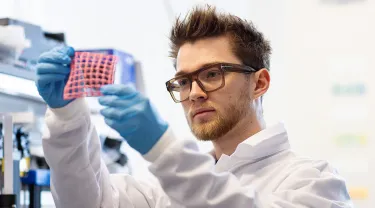Researchers at Tufts SilkLab have developed a process for breaking silk fibers down to their basic protein element—silk fibroin—and modifying the fibroin’s chemical properties. Doing so has allowed them to create a vast range of sustainable applications (for example, leather-like materials, underwater glue, food-preservation material, and optical devices) and to transform the medical equipment field with, for example, organic, implantable devices and tattoo-like sensors that provide biodata.
Now, through the work of visiting scholar Timothée Leblond, the lab’s capacity for creating new products—especially environmentally friendly ones—has exponentially increased. Leblond, a Designer-researcher in a predoctoral research program at École normale supérieure Paris-Saclay, is using his time at the SilkLab to develop methods for creating 3D-printed silk-based products.
“With 3D printing, we can build highly customizable and intricate objects on demand using silk as a base material,” Leblond explained. “We can create basically anything—but without the plastics that usually are used in 3D-printing processes.”
Leblond’s research is multifaceted. First, he’s studying the properties of new silk-based materials to comprehend their composition, behavior, and future use. Also, he’s designing new 3D-printing technologies, including printheads and nozzles that will allow him to accurately give shape to silk materials.
And he’s exploring diverse applications for 3D-printed biomaterials. Some of the possible applications he’s investigating? The creation of silk-based insulation materials and the design of biodegradable products to replace petroleum-based products.
“As a designer,” he said, “I am trying to understand how we can use natural resources and biomaterials as alternatives to existing harmful ones. My aim is to generate truly sustainable products in order to reduce our environmental impact.”
The ultimate goal, Leblond added, is to reduce waste during the manufacturing process while creating objects that will naturally biodegrade. “These objects will have essentially no impact on the ecosystems we’re living in—and could also fuel those ecosystems by adding nutrients from the materials they’re made with.”
